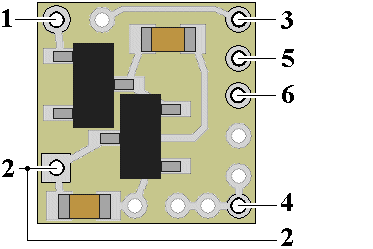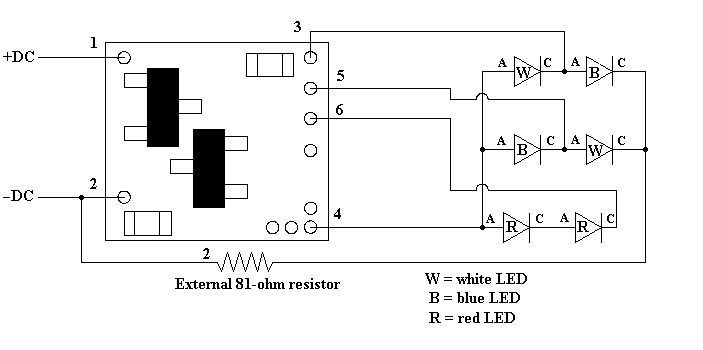Best viewed using:
Internet Explorer
or
Mozilla Firefox
Connecting the N8072 6-LED Police Strobe-bar Simulator
Installing the N8072 is very straightforward. Its tiny size and thin construction will allow it to be placed in many locations, even in the smallest scale structures. Because the module has circuitry on both sides, care must be taken to be sure that the components or wires soldered will not make contact with any metal object and cause a short circuit.
Included with the module are three 6” lengths of #32 insulated wire. If necessary, these can be used for power and input control wires. If used, we recommend the red wire be used for the + DC connection. It would be connected to solder point 1 as shown in Fig. 1. This wire could also connect through a switch to the + DC connection for remote control of the lighting effect. The other (black) wire should be connected to – DC and to solder point 2.
Any well regulated DC power source can be used to power this module providing the voltage is at least 6VDC and doesn't exceed 18VDC. Our N3512 and N3518 Power supplies are ideal for this use. Also, due to the very low power consumption, this device can also be powered by a battery, such as a standard 9-volt.
Important note: A low-wattage iron with a pointed tip should be used for connection of wires. Too much heat or solder can easily damage the wires or module and void the warranty.
Also, all connecting wires should be pre-tinned before soldering them to the module. This will make connection quick and easy and ensure excessive heat is not applied to the solder points.

Figure 1
Connecting LEDs
When wiring LEDs, proper polarity must be observed. LEDs are “polarity sensitive” and will not function if wired backwards. The N8072 is configured for connection of four (4) 20 ma LEDs with device voltages of 2.8-3.3 VDC. This covers Ngineering’s Micro white and blue LEDs, and Nano white and blue LEDs. The N8072 is also configured for the connection of two (2) 20ma LEDs with a device voltage of 1.75-2.0 VDC. This covers Ngineering’s Micro and Nano red or yellow LEDs.
In Figure 2 below, LEDs are shown with letters identifying their color and have their anode (+) and cathode(-) connections identified by A and C.
Note that the LEDs are connected as 3 series-pair groups Also note that the anode of the first LED in each pair is connected with each other pair then connected to the solder point 4.
Further, note that the last cathode of each pair is connected together and then wired in series to an external 81-ohm resistor and then connected back to solder point 2. This resistor (marked 80R6) is supplied with the N8072 (plus a spare).
The N8072 controls the lighting of the 6 LEDs with control wires connected as follows:
Solder point 3 is wired to the junction of first white LED cathode and first blue LED anode.
Solder point 5 is wired to the junction of second blue LED cathode and second white LED anode.
Note Instruction errata effective February 24, 2014:
Printed instructions for this Simulator incorrectly stated:
"Solder point 6 is wired to the junction of first red LED cathode and second red LED anode".
Instructions should read:
Solder point 6 is wired to the cathode of the second red LED in the series-pair as shown in Figure 2.
This wiring scheme plus the Simulator’s on-board program will produce the following strobe sequence:
Four short strobe bursts of the first white and second blue LEDs together, followed by two short bursts of the two red LEDs, followed by four short bursts of the first blue and second white LEDs, then two more short bursts of the two red LEDs…
Then the sequence repeats again.
Using wire appropriate for the size of the LEDs and their placement in the project, connect the LEDs as shown in Fig. 2 below.

Figure 2
Once again, be sure to use a low-wattage soldering iron when connecting wires to the module. Our N40M2 12-watt Iron with either the N408I (iron clad) Needle Tip, or the N408X (bare copper) Needle Tip would be an excellent choice for this operation.
This completes hookup of our N8072 Police Strobe-bar module. We hope the added realism it provides enhances your enjoyment of the hobby.
© 2012 Ngineering





















